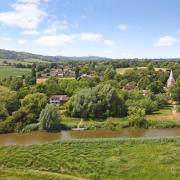They’re practical but walkways can also make a design statement in an outside space too, so here’s some inspiration which might make you want to be led up the garden path
Being led down the garden path isn’t, as the old saying goes, a waste of time. As well as providing access, and getting you from point A to B, paths help you navigate space, whether to the front door, leading to a focal point, another section of the garden, or whimsically allowing you just to meander through a woodland or meadow at your leisure.

They have a purpose but paths also give you the opportunity to complement the design ethos of your home and garden. Take a wander this month through autumnal gardens, admiring the foliage on the turn, and final crescendo of colour, but also the paths you are treading on.
Be inspired to create these defined ribbons and links, to make scenic rambles through plantings or essential access ways in the shortest time. Consider the purpose of the path, the surfaces you like, and which are also good for the environment; the shapes - curved or straight? - and what will work in harmony with the landscape. Look at the colours already in your garden and the architecture of your house to guide your hard landscaping and plant palette choices, to echo tones or contrast them.
Here are five types of paths which create a style statement as well as being practical.
Drought tolerant

Gravel paths work particularly well in country gardens, such as at Parham House and West Dean, fringed by the dense herbaceous borders billowing with late season free-flowing texture and colour, or winding through the masterful planting by the late John Brookes at Denmans Garden. Economical and easy to construct, you can create many different shapes, whether straight or curvy, with neatly defined edges visible or plants gently spilling over hiding the boundary.

Pebbles and gravel can be laid loose, and are ideal for small areas where paving would be difficult or impractical. Many plants will grow happily among the gravel for pretty effects and contribute to a relaxed feel. A compact base is essential, which could be the soil if hard clay, or otherwise if the sub-soil is soft. A tamped down stone pack or hardcore, and a lining of landscape permeable membrane will help keep down weeds. If you need to contain the path where it abuts, edge in brick, concrete or timber, especially where it may wash away down a slope. Gravel and hoggin, a mix of gravel, sand and clay that binds yet allows water to drain, are ideal for dry gardens. The all-weather surface of self-binding gravel edged in Horsham stone in the winter garden at Wakehurst, set off by the dazzling red stems of cornus and parchment ornamental grasses, is another wonderful example.
Chip off the block
Bark and wood chippings are a natural fit with the dappled woodland at Bates Green but you can also be inspired by the wood chip paths snaking creatively at Sussex Prairies, among the blocks and swathes of grasses and perennials. This type of path also protects from erosion while mulching and supressing weeds. Look for sources that haven’t used pesticides as they can affect plant growth and animal health. It’s advisable to top it up as needed, as it will naturally break down over time. As well as buying the products you can use chippings or shredding from your garden’s pruning, and felling of large branches and trunks. The RHS recommends broadleaf and conifers as they are an excellent protective layer, decomposing slowly, making them longer-lived which will reduce the need to re-apply, while absorbing moisture and releasing it back slowly.
Perfect paving

Paving with stone or brick is the most usual option for outdoor living areas and paths because of their durability and timeless, textured beauty. Recycled bricks give an instant aged and weathered look. Paving designs can be simple as neutral foils to the planting or dynamic in their own right with interlocking patterns, as at Great Dixter where pebbles are set in mosaic patterns. The design can vary along the path or be edged with a contrasting material. Bear in mind that too much pattern can look busy and reduce the appearance of size, while linear designs will draw you along to the end point. For a unified look select options that match in with your walls and patio, such as stone local to the area. A level surface and good planning are the key things to keep in mind. It is important that the subsurface or ground is stable so that the pavers won’t move.
Step this way

If you are looking for a path that’s easy to lay, consider stepping-stones. They can be placed across a lawn, set in bark or gravel, as in the Japanese garden area at The Old Vicarage, or even in a garden bed for access, as straight paths or curved, softened with groundcovers between or as a visual statement on their own. Dig the lawn or soil to allow for the thickness of the paver, plus a shallow depth of bedding sand. Make sure they are set in perfectly in lawn so you can easily mow it. Stepping-stones give a sense of rhythm and visual movement. Remember to test out the spacing for comfortable walking as well as visual appeal. To increase the impression of length, decrease the size of the steps as you progress. You can be creative with your material choices – from sawn timber, off-cuts from a fallen tree, concrete slabs, to stone pavers, and you may even like to make your own mosaic stepping-stones. Timber offcuts set into bark-chip paths in the woodland at The Old Vicarage make a simple and affective path.
Serene in green

Mown paths in large areas of grass, woodland, or meadows are the simplest solution and look so beautifully atmospheric as the breezes catch. A mix of gravel, stone and grass paths keep the naturalistic enchantment at High Beeches, a woodland garden that is ablaze with foliage colour through October. Wide lawn paths are a classic choice for strolling and unify other areas of lawn. Place a bench, arbour or large urn at the end of the promenade as a destination point. A mown grass path feels spontaneous and allows you to be immersed in the abundant life of a wild space, exploring from within. Yes it will be muddy at times, needing wellies, and isn’t for high traffic, but nothing feels better than a fine-weather barefoot wander on soft grass. Even in a small lawn you can let some areas grow long and mow a walkway. Your path or paths could be straight, meandering organically, or spiralling through the landscape, plus a grass path is inexpensive and easy to maintain with the mower.
To know
• Parham House and Gardens, Storrington, RH20 4HS
April to Sun 8th October
Wed, Thurs, Fri, Sun, BHM (12-5)
Adm £15, chd £7.50, house and garden
Web: parhaminsussex.co.uk
• West Dean Gardens, nr Chichester, PO18 0RX
Daily through the year, see website for details (10.30 – 4/5)
Adm £12/13.20 - £7.50/8.25
Web: westdean.ac.uk
• Denmans, Fontwell, BN18 0SU
Open daily, booking encouraged, see website for details
Adm £9, chd £7
Web: denmans.org
• Wakehurst, Haywards Heath, RH17 6TN
Daily (10-6)
Adm £16.50, chd free, NT free (car parking charge applies)
Web: kew.org
• Bates Green, Arlington, BN26 6SH
Every Wednesday until 25th October
Adm £7, chd £3.50
Web: batesgreengarden.co.uk
• Sussex Prairies
Wed to Sun until 15th October (1-5)
Adm £10, chd £5
Web: sussexprairies.co.uk
• Great Dixter House and Gardens, Northiam, TN31 6PH
Open Tues to Sun and BHM (11-5)
Web: greatdixter.co.uk
• The Old Vicarage, Washington, RH20 4AS
Thursdays to 12 October (10.30-4.30)
Pre-booking essential
Web: ngs.org.uk
• High Beeches, Handcross, RH17 6HQ
Open daily until 31st October, closed Wednesdays, (1-5)
Web: highbeeches.com
Get the look
Up the garden path tips
• Use permeable paving to help prevent flooding
• Consider the practical purposes – do you need to get a wheelbarrow along it, or be wide enough for two people to walk side by side?
• Long, thin paths accentuate a narrow garden, while one that sweeps from side to side gives the illusion that the space is wider
• Repetition of plants or topiary lends definition and draws the eye laterally
• A simple bend in a path or an arrangement of containers can reduce the linear rigidity
• Use set-out paint or dry sand to mark the shape of your path, then after digging hammer wooden stakes along both sides and run a stringline between stakes to give the exact line and level
• Don’t forget nature – soften paths with spillover plants, in crevices or trimmed low hedging
• Leave some unpaved squares here and there and plant with herbs such as thyme or chamomile
• You can transform a dull path by using a mix of different materials but keep the overall look cohesive
• A path can be a visual diversion by drawing the eye away from an eye-sore
• Shallow steps create a gradual descent to bridge different levels
• The path to the front door should be obvious, easy to negotiate and welcoming for visitors
• Opt for recycled if possible, factor in provenance, buying local to reduce fuel usage and carbon footprint, using ethically certified materials to help keep the supply chain safe, especially in the quarries



























